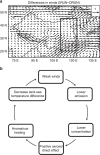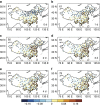Dust-wind interactions can intensify aerosol pollution over eastern China
- PMID: 28492276
- PMCID: PMC5437281
- DOI: 10.1038/ncomms15333
Dust-wind interactions can intensify aerosol pollution over eastern China
Abstract
Eastern China has experienced severe and persistent winter haze episodes in recent years due to intensification of aerosol pollution. In addition to anthropogenic emissions, the winter aerosol pollution over eastern China is associated with unusual meteorological conditions, including weaker wind speeds. Here we show, based on model simulations, that during years with decreased wind speed, large decreases in dust emissions (29%) moderate the wintertime land-sea surface air temperature difference and further decrease winds by -0.06 (±0.05) m s-1 averaged over eastern China. The dust-induced lower winds enhance stagnation of air and account for about 13% of increasing aerosol concentrations over eastern China. Although recent increases in anthropogenic emissions are the main factor causing haze over eastern China, we conclude that natural emissions also exert a significant influence on the increases in wintertime aerosol concentrations, with important implications that need to be taken into account by air quality studies.
Conflict of interest statement
The authors declare no competing financial interests.
Figures





References
-
- Ding Y. H. & Liu Y. J. Analysis of long-term variations of fog and haze in China in recent 50 years and their relations with atmospheric humidity. Sci. China Earth Sci. 57, 36–46 (2014).
-
- Huang R. et al.. High secondary aerosol contribution to particulate pollution during haze events in China. Nature 514, 218–222 (2014). - PubMed
-
- Zhang R. H., Li Q. & Zhang R. N. Meteorological conditions for the persistent severe fog and haze event over eastern China in January 2013. Sci. China Earth Sci. 57, 26–35 (2014).
-
- Xu P., Chen Y. F. & Ye X. J. Haze, air pollution, and health in China. Lancet 382, 2067 (2013). - PubMed
-
- Qian Y., Kaiser D. P., Leung L. R. & Xu M. More frequent cloud-free sky and less surface solar radiation in China from 1955 to 2000. Geophys. Res. Lett. 33, L01812 (2006).
Publication types
LinkOut - more resources
Full Text Sources
Other Literature Sources
Molecular Biology Databases

